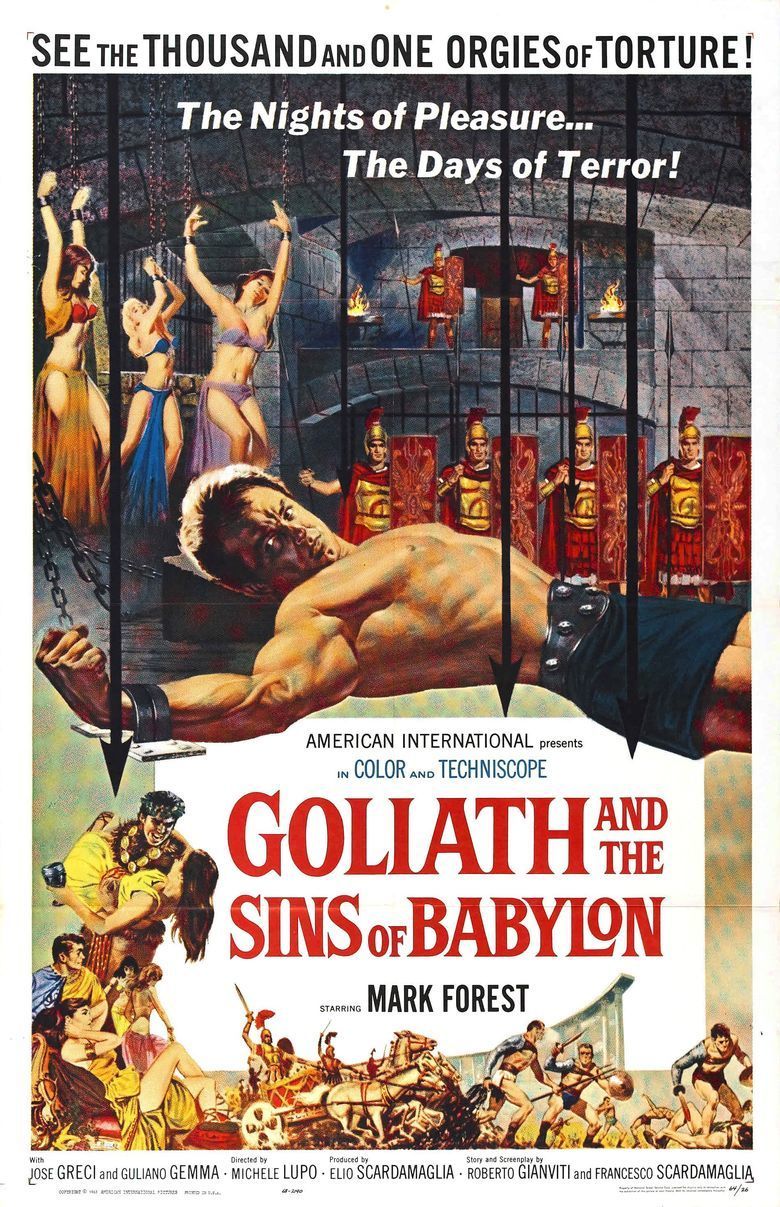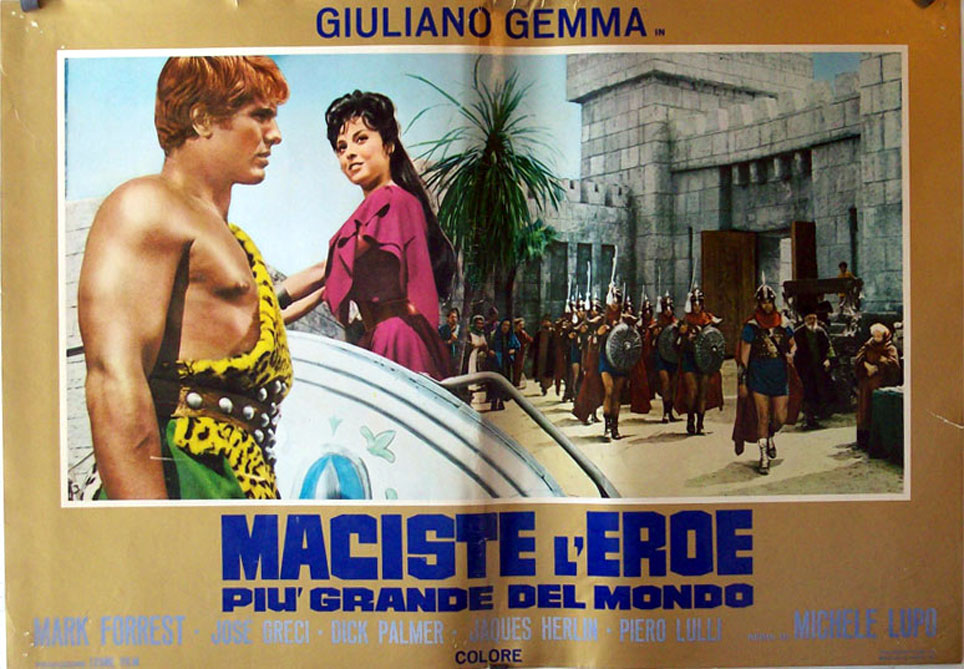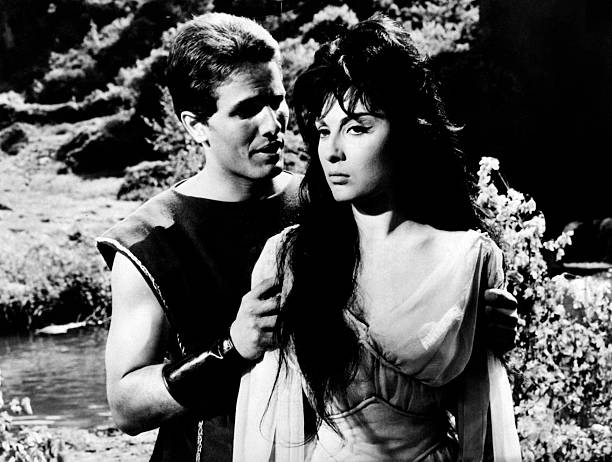Peplum Populist: Goliath and the Sins of Babylon (1963)
 When you have an Italian sword-and-sandal (peplum) film, and the hero of the title has an oblique name like “Goliath” or “Colossus,” the immediate question that comes to mind is, “Is this hero actually Maciste?”
When you have an Italian sword-and-sandal (peplum) film, and the hero of the title has an oblique name like “Goliath” or “Colossus,” the immediate question that comes to mind is, “Is this hero actually Maciste?”
The answer with Goliath and the Sins of Babylon is “Yes.” The Italian title of this 1963 muscleman epic is Maciste l’eroe più grande del mondo, “Maciste, The Greatest Hero in the World.” This isn’t strictly true, because in the rest of the world, Maciste habitually lost his name and was turned into Hercules or Atlas or Colossus … or Goliath.
And Maciste isn’t even in Babylon! This is another deception of the English-language title and dub. The setting is the usual vague Greco-Roman Mediterranean world that served as the backdrop for the majority of peplum flicks, where fictional kingdoms constantly warred with each other until a bulky hero appeared to help the underdogs to victory.
The story of Goliath and the Sins of Babylon isn’t much more complex than that description, although the events of the plot as it lunges from scene to scene create a needless tangle. The short version: The Kingdom of Cafaus (“Babylon”) has forced a cruel treaty on its neighbor, Nephyr, that demands an annual tribute of twenty-four virgins (upped to thirty in the English version). The current king of Nephyr, Pergasos (Piero Lulli), arranged for this awful treaty so he could keep the throne after his brother’s death. The wandering strongman Maciste (Mark Forest) arrives in Nephyr and befriends a group of rebel gladiators who plot to free the city from the grip of the king of Cafaus and his wicked agent, Morakeb (Erno Crisa), and place Regia (José Greci), daughter of the previous king, onto the throne of Nephyr.
Between the lines of this story is a naval battle, a chariot race, copious sword fights and wrestling moves, a populist uprising, a pitched battle between armies on horseback, a rush of lions and leopards mauling everybody in sight, comic antics with a dwarf, and jarring shifts in the story that can make it tricky to follow the specifics. There’s a lot packed into this movie, including chunks of other movies, which makes for a choppy narrative and moments of, “Wait, who is this guy again?”
But Goliath and the Sins of Babylon is also an immense load of fun as pure sword-and-sandal cheese. The action set-pieces are almost wall-to-wall, and with the exception of groaner comedy moments (centered on the dwarf character, a common peplum cliché), they’re well executed. You’ll soon learn to ignore the attempts of the plot to throw you off with its swerves: just keep in mind, as long as Maciste and his buddies beat up enough of the guys dressed in black with silly helmets, the good guys win!
One of the measuring sticks for quality I use for peplum films is if they contain at least one bizarre, over-the-top sequence that sticks in my gray matter after I’ve forgotten everything else. Sins of Babylon has a slew of major set-pieces, with two Ben-Hur scenes ticked off the list within the first half hour: a trireme battle and a chariot race. Both are enough for me to recommend the film, even though they’re hybrids constructed around scenes taken from two other Italian pepla: Theodora, Slave Empress (1954) and Carthage in Flames (1960). There are bounteous amounts of brawls and sword fights as well, jamming the film with action and robust stunt work.
But the winner for memorable over-the-top sequence is the death trap Morakeb puts Maciste into. Even if the rest of Goliath and the Sins of Babylon were as bland as Colossus of the Stone Age, I’d still tell people to check it out — or speed forward to the ninety-minute mark — just to watch this part.
 The trap is a torture device that would do Jigsaw proud: a table set beneath a series of holes in the ceiling, each which drops down a massive spike onto the table when a rope is cut. Some of the falling spikes will miss the man strapped to the table, others will wound him, and one will deliver a deathblow. Morakeb trammels Maciste to the table and challenges the hero’s companions to cut ropes as a test of their professed loyalty to the king of Cafaus. It’s a freakishly tense sequence, shot for maximum impact as each spike plunges down from its hole and slams into the table near Maciste’s body. It delivers on Morakeb’s promise that the anticipation of the killing blow is the worst part of an execution. The scene doesn’t hit a grand climax, but for a heroic adventure movie it couldn’t have gone full gruesome.
The trap is a torture device that would do Jigsaw proud: a table set beneath a series of holes in the ceiling, each which drops down a massive spike onto the table when a rope is cut. Some of the falling spikes will miss the man strapped to the table, others will wound him, and one will deliver a deathblow. Morakeb trammels Maciste to the table and challenges the hero’s companions to cut ropes as a test of their professed loyalty to the king of Cafaus. It’s a freakishly tense sequence, shot for maximum impact as each spike plunges down from its hole and slams into the table near Maciste’s body. It delivers on Morakeb’s promise that the anticipation of the killing blow is the worst part of an execution. The scene doesn’t hit a grand climax, but for a heroic adventure movie it couldn’t have gone full gruesome.
The chariot race is probably the reason Sins of Babylon was pieced together the way it is. The race combines footage from a pre-Hercules peplum, Theodora, Slave Empress, with new footage of Mark Forest and José Greci racing against a single stretch of wall. This type of recycling often occurred in sword-and-sandal films, but the execution is smooth and few viewers will notice that all the wide shots of the race and the arena are lifted from a film almost a decade older and shot in a different aspect ratio. One giveaway to the cheat is a banner flying the sigil of the Byzantine Empire that pops up in the wide shots, but only history aficionados will catch this. A similar error happens in the horseback battle, where Roman standards reveal shots taken from Carthage in Flames. Carthage in actual flames is what stands in for the burning of Cafaus/Babylon at the climax.
The chariot race creates a problem for the scenes around it, however, because it doesn’t serve any purpose to the rest of the story. It exists because the filmmakers had great charioteering footage they could use to make a budget-friendly spectacle. It doesn’t make much sense for Princess Regia to compete in a race where losing would benefit her: she has to marry whoever bests her in the race, and this would immediately remove her treacherous uncle Pergasos from power. Maciste wins the race, substituting at the last second for Regia’s actual love interest, Xandros (a switch that requires unnecessary scenes of set-up and Regia deceiving Xandros that she’s someone else). But the results of the race don’t matter because two scenes later Pergasos discovers Maciste is allied with the rebel gladiators and attempts to have him arrested. However, if I demanded seamless storytelling from my sword-and-sandal films I’d have few to watch.
There are other spots where the filmmakers lean on pre-existing footage, such as an abrupt attack from lions and leopards unleashed from the gladiatorial pits during a street fight in Nephyr. The rapid cutting to close-ups of the attack makes it look like the filmmakers are disguising mismatched footage. The guards in the previous battle scene wear uniforms seen nowhere else in the movie, and it’s probably so they would match the guards in the lion-attack footage. I found images of guards in similar uniforms in stills from Theodora, so my guess is the filmmakers grabbed these costumes from storage so they could use the cat attack footage. Honestly, this doesn’t bother me; film detective work like this can be fun, and as a Tarzan fan I appreciate a good lion-mauling, no matter the source. Besides, Theodora, Slave Empress is almost impossible to find on video or streaming, so the footage will be new to most viewers.
 Mark Forest (real name Lou Degni, a Brooklyn-born bodybuilder) is so far the best Maciste I’ve seen. He looks great in the fights and appears engaged with the other actors when he isn’t beating people up. I know this is a low bar, but just look at how vacant Kirk Morris is most of the time when he’s playing the character. Maciste doesn’t have as commanding a role as he often does, but that’s because the film is jammed with characters and Maciste must share heroic duties with the other gladiators like Xandros (Giuliano Gemma) and Alceas (Mimmo Palmara, who had a major role in Hercules).
Mark Forest (real name Lou Degni, a Brooklyn-born bodybuilder) is so far the best Maciste I’ve seen. He looks great in the fights and appears engaged with the other actors when he isn’t beating people up. I know this is a low bar, but just look at how vacant Kirk Morris is most of the time when he’s playing the character. Maciste doesn’t have as commanding a role as he often does, but that’s because the film is jammed with characters and Maciste must share heroic duties with the other gladiators like Xandros (Giuliano Gemma) and Alceas (Mimmo Palmara, who had a major role in Hercules).
Giuliano Gemma as Xandros doesn’t exactly steal the movie from Mark Forest, but the handsome actor puts up a strong front to be considered a true co-star as both the lead in the romantic subplot and a darned impressive brawler in the action. It’s obvious why Gemma continued to have a healthy career as a leading man in Italy with numerous Westerns to his credit, such as The Man from Nowhere (1966), which was directed by Goliath and the Sins of Babylon’s Michele Lupo. Gemma’s most interesting Western role is in The Price of Power (1969), a no-kidding re-telling of the JFK assassination in the Old West that I may have to write about someday. Gemma died in a tragic car accident in 2013.
Director Michele Lupo has a stack of sword-and-sandal credits. Sins of Babylon was his second; he’d already directed Mark Forest as Maciste in Colossus of the Arena (1962), which also co-starred José Greci as the leading lady. Lupo continued with Seven Slaves Against the World (1964), Seven Rebel Gladiators (1965), and The Revenge of Spartacus (1965) right as the genre was about to sputter out. German actress Scialla Gabel (The White Warrior, Tarzan’s Greatest Adventure) appeared in all these films except Sins of Babylon. When the sword-and-sandal boom crashed, Lupo transitioned to crime films. Fast action and erratic storytelling appear to be his trademarks, but sword-and-sandal movies generally went this way in their dwindling years.
Retromedia has released a widescreen DVD of Goliath and the Sins of Babylon paired with Colossus and the Amazon Queen (astonishingly not a re-named Maciste film). Amazon VOD has a streaming version of dreadful quality that isn’t even free for Prime subscribers. Because the movie is in the public domain like most Italian sword-and-sandal films, there are a number of beautiful complete prints posted on YouTube, both in the dubbed English version and the uncut Italian one, which is ten minutes longer and a bit easier to follow, although lacking English subtitles.
Ryan Harvey is one of the original bloggers for Black Gate, starting in 2008. He received the Writers of the Future Award for his short story “An Acolyte of Black Spires,” and his stories “The Sorrowless Thief” and “Stand at Dubun-Geb” are available in Black Gate online fiction. A further Ahn-Tarqa adventure, “Farewell to Tyrn”, is currently available as an e-book. Ryan lives in Costa Mesa, California where he works as a professional writer for a marketing company. Occasionally, people ask him to talk about Edgar Rice Burroughs or Godzilla in interviews.
[…] with no actual Goliath in the movie, though, there’s also no Babylon. Per this interesting article, the film’s wicked city is a fictional “Kingdom of Cafaus,” located Somewhere in Cinematic […]